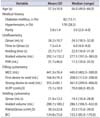1. Araki I, Zakoji H, Komuro M, Furuya Y, Fukasawa M, Takihana Y, et al. Lower urinary tract symptoms in men and women without underlying disease causing micturition disorder: a cross-sectional study assessing the natural history of bladder function. J Urol. 2003; 170:1901–1904.
2. Kakizaki H, Matsuura S, Mitsui T, Ameda K, Tanaka H, Koyanagi T. Questionnaire analysis on sex difference in lower urinary tract symptoms. Urology. 2002; 59:58–62.
3. Lee YS, Lee KS, Jung JH, Han DH, Oh SJ, Seo JT, et al. Prevalence of overactive bladder, urinary incontinence, and lower urinary tract symptoms: results of Korean EPIC study. World J Urol. 2011; 29:185–190.
4. Stav K, Dwyer PL, Rosamilia A, Schierlitz L, Lim YN, Lee J. Midurethral sling procedures for stress urinary incontinence in women over 80 years. Neurourol Urodyn. 2010; 29:1262–1266.
5. Dwyer PL, Desmedt E. Impaired bladder emptying in women. Aust N Z J Obstet Gynaecol. 1994; 34:73–78.
6. Clarke B. The role of urodynamic assessment in the diagnosis of lower urinary tract disorders. Int Urogynecol J Pelvic Floor Dysfunct. 1997; 8:196–199.
7. Groutz A, Gordon D, Lessing JB, Wolman I, Jaffa A, David MP. Prevalence and characteristics of voiding difficulties in women: are subjective symptoms substantiated by objective urodynamic data? Urology. 1999; 54:268–272.
8. Schafer W, Abrams P, Liao L, Mattiasson A, Pesce F, Spangberg A, et al. Good urodynamic practices: uroflowmetry, filling cystometry, and pressure-flow studies. Neurourol Urodyn. 2002; 21:261–274.
9. Abrams P, Cardozo L, Fall M, Griffiths D, Rosier P, Ulmsten U, et al. The standardisation of terminology in lower urinary tract function: Report from the standardisation sub-committee of the International Continence Society. Urology. 2003; 61:37–49.
10. Valentini FA, Robain G, Marti BG. Urodynamics in women from menopause to oldest age: what motive? What diagnosis? Int Braz J Urol. 2011; 37:100–107.
11. Zimmern P, Litman HJ, Nager CW, Lemack GE, Richter HE, Sirls L, et al. Effect of aging on storage and voiding function in women with stress predominant urinary incontinence. J Urol. 2014; 192:464–468.
12. Basu M, Postlethwaite C, Cheema K, Duckett J. The effect of age on pressure flow parameters in women with lower urinary tract symptoms. J Obstet Gynaecol. 2013; 33:873–876.
13. Malek JM, Ellington DR, Jauk V, Szychowski JM, Parden AM, Richter HE. The effect of age on stress and urgency urinary incontinence outcomes in women undergoing primary midurethral sling. Int Urogynecol J. 2014; 12. 16. [Epub].
http://dx.doi.org/10.1007/s00192-014-2594-4.






 PDF
PDF ePub
ePub Citation
Citation Print
Print


 XML Download
XML Download